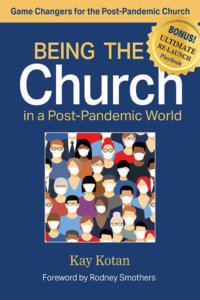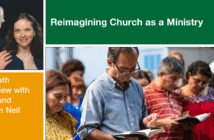Kay Kotan says many churches feel a natural desire to return to the familiar, comfortable patterns of the past. But churches that embrace this time of disruption as a catalyst for lasting change are most likely to be vital in the post-pandemic world.
The church as we knew it before the pandemic no longer exists. Yet, we do not know what the church of the future will be. One thing we know for sure is that it will be different. It needs to be different. In fact, it has to be different! If we are to be the church to reach new people, we must show up in different and new ways. We must shed the methods that no longer serve the church and be open to being the church in new and yet to be determined ways.
After we exit the stage of liminality, we will begin the time of reorientation. We would all like to know where we are headed, what the future will look like, how it will be different, and what we will be doing. Unfortunately, we must also acknowledge that even this will be another difficult phase of adjusting, re-learning, and adapting. Still another season of being uncomfortable. We are in divergent times. Things are developing differently, or perhaps in different directions. While we would all love the perceived certainty we had in January 2020, we must face the reality of where our feet are planted, acknowledging we will need to move in unknown directions in the moments, days, and years to come.
Opportunity is born out of crisis.
The global pandemic has been horrific. No one could have predicted such chaos to occur or for so long. Yet, there is opportunity, the proverbial silver lining. Crisis is an accelerator. The church has been catapulted into the digital age. Some churches had no choice but to embrace technology they once refused. Congregations learned there are more ways to offer worship than we had previously imagined. We learned it is possible to engage people in online ministry that might never become involved in on-site ministry. The church learned that it could change, and it was forced to change quickly.
During a pandemic period when everything seems to turn upside down, there is an opportunity to stop some things that had not been working anyway, eliminate some things that were seemingly impossible in “normal” times, and start new things that might have been hard to imagine in the past.
A mere interruption or a blessed disruption?
When we look at the pandemic as an interruption, we are seeing it as a delay. It is though we hit the pause button and when the world returns to “normal,” we will simply hit the play button again. On the contrary, disruption is defined as “a major disturbance, something that changes your plans or interrupts some event or process”, or “a break in the action — especially an unplanned and confusing one.” (Vocabulary.com.)
When the church sees the pandemic as a disruption, the leaders embrace the opportunity of knowing that going back is no longer an option. Disruption allows a church the opportunity to be awakened to the need for change at a much deeper level.
“I know the plans I have for you,” announces the Lord. “I want you to enjoy success. I do not plan to harm you. I will give you hope for the years to come.” (Jeremiah 29:11 NIRV)
Embracing disruption is the key to vitality.
While we all mourn the days of the past for what felt normal and comfortable, churches that embrace this as a time of disruption will likely be the most vital churches in the post-pandemic world. God wants the church to be healthy, vital, growing, and fruitful. We must understand that church health and vitality might look very different in the future.
As the church begins to emerge from the pandemic, its role is changing. It was already changing pre-pandemic, but the change is sure to escalate drastically post-pandemic. Effective churches will not look at the average worship attendance as the standard barometer for health. Rather, they will be focusing on engagement. How people are engaging in the church through ministries such as discipleship, service, worship, and evangelism will become the new barometer. This single example of changing how we measure the health of the church magnifies the shift required from a time of interruption to a time of disruption.
The pandemic has created a wake-up call for churches and its leaders. How will churches respond? The choice will be up to each individual church and its leaders. Will the pandemic be framed as a disruption that provides hope for new possibilities in the days to come? Or will the pandemic be framed as a brief interruption, simply waiting for a return to the days gone by?
No doubt, those that are able to see the pandemic in terms of a blessed interruption, providing new eyes and energy for what God is calling the church to be, will be the vital churches of the future.
 This article is adapted from Being the Church in a Post-Pandemic World (Market Square Books, 2021) by Kay Kotan. Used by permission. The book is available at Cokesbury and Amazon.
This article is adapted from Being the Church in a Post-Pandemic World (Market Square Books, 2021) by Kay Kotan. Used by permission. The book is available at Cokesbury and Amazon.
Related Resources
- What Will Your Church Look Like Post-COVID-19? by Barry Winders
- New Questions for a New Day by Michelle Snyder
- Leading When You Don’t Know the Way by Susan Beaumont







